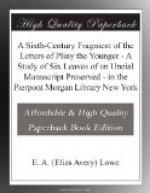Traube, l.c., No. 60; Old Latin Biblical Texts, Vol. II, Oxford 1886; Palaeographical Society, II. pl. 50; Steffens{1}, pl. 15; E. Chatelain, Uncialis scriptura, pl. I, 1; A. Chroust, Monumenta Palaeographica, XVII, pl. 3.
[Sidenote: Characteristics of the oldest uncial manuscripts]
The main characteristics of the manuscripts included in the above list, which is by no means complete, may briefly be described thus:
1. General effect of
compactness. This is the result of scriptura
continua, which knows
no separation of words and no punctuation.
See the facsimiles cited above.
2. Precision in the mode of shading. The alternation of stressed and unstressed strokes is very regular. The two arcs of {O} are shaded not in the middle, as in Greek uncials, but in the lower left and upper right parts of the letter, so that the space enclosed by the two arcs resembles an ellipse leaning to the left at an angle of about 45 deg., thus {O}. What is true of the {O} is true of other curved strokes. The strokes are often very short, mere touches of pen to parchment, like brush work. Often they are unconnected, thus giving a mere suggestion of the form. The attack or fore-stroke as well as the finishing stroke is a very fine, oblique hair-line.[30]
[Footnote 30: In later uncials the
fore-stroke is often a horizontal
hair-line.]
3. Absence of long ascending or descending strokes. The letters lie virtually between two lines (instead of between four as in later uncials), the upper and lower shafts of letters like {H L P Q} projecting but slightly beyond the head and base lines.
4. The broadness of the letters {M N U}
5. The relative narrowness of the letters {F L P S T}
6. The manner of forming {B E L M N P S T}
B with
the lower bow considerably larger than the upper, which
often has the
form of a mere comma.
E with
the tongue or horizontal stroke placed not in the
middle, as in
later uncial manuscripts, but high above it, and
extending beyond
the upper curve. The loop is often left open.
L with very small base.
M with
the initial stroke tending to be a straight line
instead of the
well-rounded bow of later uncials.
N with the oblique connecting stroke shaded.
P with the loop very small and often open.
S with
a rather longish form and shallow curves, as compared
with the broad
form and ample curves of later uncials.
T with
a very small, sinuous horizontal top stroke (except
at
the beginning
of a line when it often has an exaggerated
extension to the
left).




